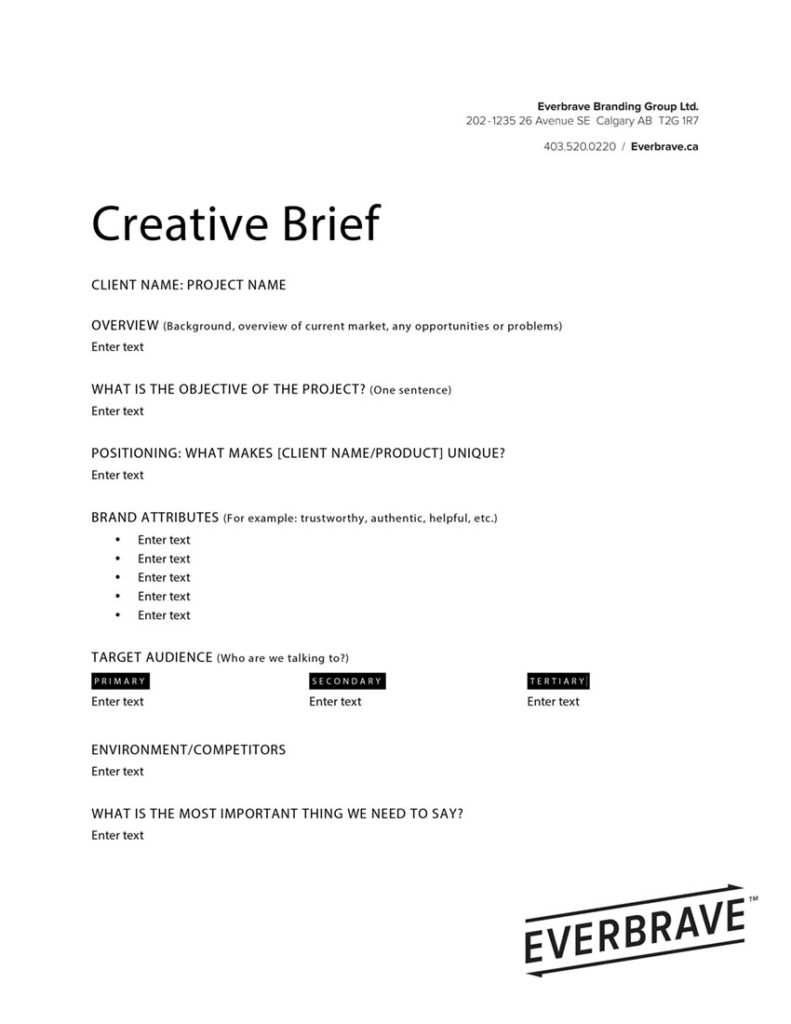Relationship Goals: Feedback and Collaboration
The Key to a Successful Client-Designer Partnership
The secret sauce to any design or creative process is client-designer collaboration. A key ingredient in this relationship is feedback. Another is having the tools and creative processes in place to facilitate the feedback in a professional, courteous manner.
As a client, you may run into a designer that is emotional—they seem to take your feedback like a personal insult. As a result, you may feel it’s a challenge to get your point across. Stuck in a weird, awkward dance circling the actual issues. Or perhaps you have crossed-paths with a designer who is always questioning your knowledge of your business, which unfortunately can come across as a touch arrogant or egotistical.
The creative brief is your road map to success. It’s a tool that provides you an internal check.
And then there are times as a designer when you feel misunderstood. You’re a communicator AND an artist — you feel like there’s a constant internal battle between what is subjective and what is objective.
In my experience, the root of any client-designer conflict comes down to a simple lack of communication. But putting the proper tools and processes in place to facilitate feedback on the onset of a project can help solve the conflict. This creates a way in which you, and your client, can collaborate and move forward.
You might also want to read Bringing Ideas to Life: The Secrets to Great Graphic Design to help you navigate the creative process.
The Basics of Feedback for Designers and Clients
When you and a client seem at odds, the first thing you should refer to is your creative brief. Did you create one for this project? Did the client approve it?
The creative brief is your road map to success. It’s a tool that provides you with an internal check—a way to look back and determine if the work presented clearly communicates the objectives set forth by the client.
When you disregard the creative brief, you are putting the work into the subjective realm. I’ve had many friends hire “branding agencies” to design a logo, and when they ask me for my opinion on the result, my first question is always, was there a creative brief? I would say about 99% of the time, they say no. If there is no brief, I cannot give them good, constructive feedback. It would just be a subjective opinion.
A creative brief is a check-and-balance tool for both designer and client in these ways:
Collaboratively:
- It clearly defines scope of the project for both the creative team and the client—what is the problem we are trying to solve.
- What is the real purpose or aim of the project—the creative brief makes sure both the creative team and the client are on the same page before moving forward.
Within each profession:
- For the client, it’s an opportunity to decide who the decision-makers will be. Everyone will have an opinion, and you should only include people who can think objectively about your brand. People who can look at the work from your audience’s perspective.
- For the designer, it’s an opportunity for you to identify a target audience and create work that will compel and captivate that group. I find understanding the target audience is the most crucial part of the creative process.
From my experience, most successful projects happen when there is a solid collaboration
between the client and the designer/agency.
While I truly believe that feedback is key to good creative design, I also believe that clients need to be aware of how they deliver criticism. And designers need to be mindful of how they receive it.
As the client, there is a right and wrong way to deliver good, constructive feedback to designers.
Here are my top six tips on how to deliver feedback:
- Be clear and objective. Don’t let your personal taste cloud your judgement. It’s not about what you like, it’s about the problem you’re trying to solve.
- Don’t play the guessing game. Your designer and creative team aren’t psychic. Be honest about your expectations, and what you see and don’t see.
- Do you feel like you have to art direct? Should you? The answer is no—you hired the designer/creative team because they are experienced professionals. If you find yourself art directing them, chances are you have trust issues with them. Or perhaps the scope of the project wasn’t communicated clearly.
- Filter through your teams’ feedback before sending it to the design team. The last thing you want to do is send the designers a string of emails and expect them not to miss anything.
- It’s ok to have love at first sight. Don’t give feedback for the sake of feedback. Sometimes all stars align and everything just works, so trust your gut and leave it the way it is.
- Be respectful and professional, I recommend refraining from comments like:
- I don’t hate it
- Can you combine the two options?
- Can you add more motion to this business card design?
- I can do it myself, but I don’t have the time
- I’ll know it when I see it
Comments like these do not add value to the process or outcome. It forces the designer to make assumptions as to what you’re really looking for. Assumptions are dangerous, and it can become an endless loop that creates resentment on both sides. Instead, ask the designer why they chose that specific colour, font or graphic element. Working to understand the designer’s rationale at first will help you make the right decisions together moving forward.
As the designer, it’s inevitable you will receive negative feedback on a project you’ve spent a considerable amount of time, energy, and creative inspiration on.
Here are my top five tips on how to receive and deal with negative feedback:
- Don’t take it personally
- Give the client the benefit of the doubt and try to understand what they don’t like about the work and why.
- Take a moment to reflect, did you ask the right questions? Did you give a good rationale?
- Regroup and think big picture. Sometimes the client just knows what they want, and it won’t align with you, and the direction you think the project should go. Sometimes you just have to accept it.
- Request what you want to get feedback on, and guide that process so the client doesn’t go off track.
From my experience, most successful projects happen when there is a solid collaboration between the client and the designer/agency. The client should never think of their agency as a service provider, rather a partnership—a beneficial extension to their business. It’s a win-win situation when the client learns more about the creative process and the designer learns about the business. It helps build trust and allows feedback to become a natural part of the conversation.
At Everbrave, the creative brief is a built-in part of the creative process. The beauty of a creative brief is that it need not be complicated, just cover all the touchpoints that a designer needs to consider before starting a project for a client. Why not try it, and download the Everbrave Creative Template!




